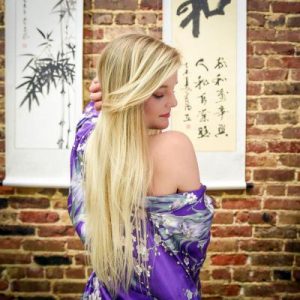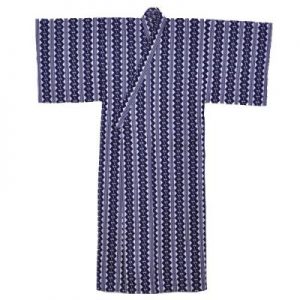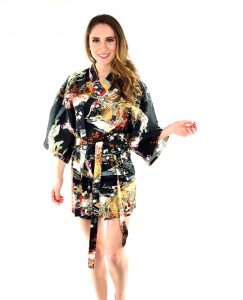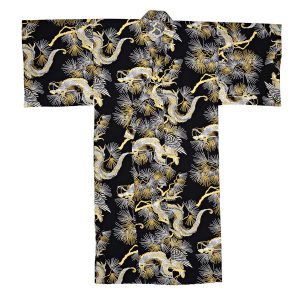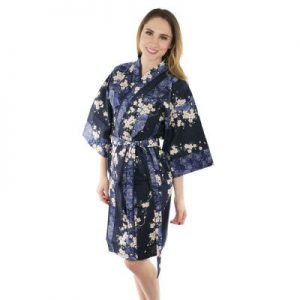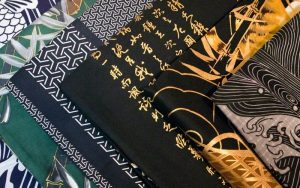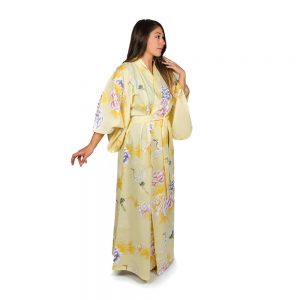It’s a long process. Starting in the farm fields, cotton seeds are planted and soon sprout. The tender plants are well cared for, nourished, watered, and grown to mature plants. The cotton is harvested and processed and woven into a giant blank canvas. From the multi-stage dying process and careful printing of the fine virgin cotton fabrics, it is on to the buyer’s markets. Our buyers are meticulously seeking out the best of the best. Fabrics must pass their vigorous inspections and only the best are purchased. The fabric bolts are delivered to the sewing rooms where production begins.
The talented seamstresses and tailors cut panels from the large bolts of materials. From there, the panels are sent to experienced artisans and sewing teams where careful attention is given to every stitch. As the process continues, what once looked like stacks of fabric jigsaw puzzle pieces, a Japanese Kimono started to take shape in the traditional form we know. Further inspections and finishing touches are checked not once or twice, but three or more times to make the final cut or approval. Once the quality assurance team gives their approval, the Kimonos and Yukatas are neatly pressed and folded, and individually packaged.
Once packaged, team members sort and stack the finished robes into boxes where they are labeled and processed for shipment. This process varies in detail depending on whether the shipment contains hundreds or thousands of Japanese robes. The method of how the goods are transported to the United States also plays into the equation. Chopa – Your Kimono Source has opted for air cargo for some time now especially because of the Covid Pandemic.
Shipping on container ships became very expensive and major delays are now the norm. We pride ourselves on offering a full selection as best as we can and air cargo eliminates many delays. Air transport isn’t cheap, but sometimes a company absorbs additional costs to serve their customers and this is something we strive to do.
While air travel is relatively quick, goods must still go through customs, and taxes and duties must be paid. Once they arrive at a major hub in the USA, our carriers work on delivering the shipment to our warehouse as quickly as possible. This normally encompasses a few shorter flights from a few states away and then finally “the last mile delivery” as it is known in the shipping world is made. Freight trucks roll up to our doors and the unloading begins.
This process includes opening boxes, and scanning and entering data into our inventory database. The reports are forwarded to our web team where they go into the back end of our website and add the new sizes, colors, and other pertinent information. Little by little over the next 3-5 days, the website is updated and dozens and dozens of sizes, styles, and colors are instantly back in stock.
We are often amazed at how quickly orders begin coming in that selected new items we just added. We have a complimentary electronic notification list if a customer wants to be notified of an out-of-stock item coming back in stock. But many customers regularly check our website and are ready to hit the BUY button when it is posted.
With social media, we announce when a new shipment is arriving. Most customers get alerted of this fact through Facebook, Twitter, or Instagram. If you don’t follow us on social media, we recommend you do. Besides announcements of new shipments, we also alert subscribers to special sales, closeouts, price reductions, and overstock deals. We also share simple news items about something of interest to our Kimono Loving Family of customers.
We try to keep it fresh and never beat anyone up with multiple posts per hour like some stores do. We want it to be relevant and interesting. As a 100% employee-owned business, we want to treat our customers the same we like to be treated. We understand what a turn-off it is to be bombarded by solicitations and advertisements. This is simply something we do not participate in.
With that said our work is cut out for us. Planes left Japan over the weekend and trucks already delivered the first shipment of many this morning. We expect more truckloads throughout the week. Our warehouse was in full operational mode this past weekend prepping for the deliveries. Our priority is to always process customer orders as soon as possible, so this doesn’t hinder getting orders out. It is an art and science but since we have been doing this for 28 years, we think we know a thing or two and make it as painless as possible. Now Go Get Your Kimono On…SHOP NOW!!




